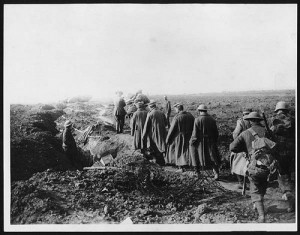Somehow Still Walking February 16, 2012
Author: Beach Combing | in : Contemporary , trackbackBeachcombing used to live on a farm next to an SS veteran who had escaped from a Soviet prisoner of war camp with four ‘through and throughs’, a lot of random shrapnel and with one of his eye balls conspicuously absent: he was a bit of a ‘card’ and refused to wear a glass eye. Beach began to think of this gentleman while writing his post on survivors of massacres the other day, because he was intrigued by those injured in the most terrible way and yet living to (ultimately) walk away.
Most of the examples in the survival post were men and women who were not actually hit but who had the supreme good sense to lie still and not do anything while homicidal maniacs raged around. But one man mentioned there, Révérien Rurangwa, definitely fits into this category. RR was 15 at the time.
On 20 April, [RR’s] family were slaughtered one by one inside the goat shed they had hidden in for a fortnight, but Révérien survived despite horrific wounds. ‘I just couldn’t seem to die,’ he says. ‘And when I asked them to kill me, they laughed and taunted me. They said, ‘Look at the cockroach crawling’. They said, ‘Hey, dead-on-legs, can’t you go any faster?’ They took bets on how long I would live.’
Regrettably Beach has never kept records of these somehow-still-walking cases, but several come to mind as he is typing. In a book he no longer owns he remembers a political prisoner in Berlin just before the Russians overwhelmed the city being taken out and shot by the Gestapo. The man in question was placed facing a wall when he turned to ask his shooters what they were doing. This act of turning meant that the bullet, instead, of passing through the nape, just clipped his neck, giving him a wound that, in the dark, looked superficially convincing. An hour later he came to and was able to walk away.
Other horrific wounds have been sustained in combat and yet somehow soldiers have survived. Beach recently came across an extraordinary example from the Second World War and from the US’s desperate Rapido River attack, a moment of conspicuous tactical stupidity on the part of Mark Clark’s Fifth Army (Jan 1944). One man made it to the German side of the river and had his chest blown open by shrapnel: a comrade stated that this was the only time he had ever seen a man’s heart beat. Yet somehow the injured man dragged himself back across the river, on a submerged Allied bridge no less, was brought to a hospital – where we are guessing hygiene was not an outstanding issue – and returned home to start his life again.
Another example that came to Beach was from the killing fields of Kohima Ridge where a group of gallant Ghurkas counter-attacking against the Japanese in 1944 were raked with machine gun fire. A British officer describes a Ghurka’s guts pouring out and the Ghurka packing them back in with handfuls of scooped Indian mud. The British officer rounds off his account (written decades after the war) with the words: ‘I still get a Christmas card from [the ‘mortally’ wounded Ghurka] each year’.
Ancient examples are more difficult to come by. Beach can think of several cases of appalling combat injuries in, say, Procopius. But in those times you survived only long enough to amaze your colleagues and get a visit from a curious physician or two.
Finally, DoE Tacitus put Beachcombing onto Rasputin’s famous death: though it seems there is serious controversy as to just how difficult it was to kill the Monster of Moscow. In short, they put not just arsenic but cobblers in his coffee: another post, another day…
Any other horrific injuries and inexplicable survivals? drbeachcombing AT yahoo DOT com
***
27 Mar 2012: Ricardo sends this in from Escaping the Bonds of Earth
The Fifties and the Sixties by Ben Evans “Aboard Voskhod 1, four years later, he would sit shoulder-to-shoulder with two men from very different backgrounds. Neither Konstantin Feoktistov nor Boris Yegorov possessed test-piloting credentials, but had established themselves as experts in the fields of physical science and medicine. Feoktistov, indeed, was lucky to be alive at all. Born on 7 February 1926 in the south-western Russian city of Voronezh, close to Ukraine, he was caught up in the Great Patriotic War shortly after the defeat at the Battle of Moscow. Amidst the retreating remnants of the Red Army, his mother gathered her belongings and, with the young Feoktistov, joined the steady stream of refugees fleeing eastwards. At a village where they stopped to rest, Feoktistov met a group of Red Army soldiers, one of whom remembered him trying to enlist a short time earlier and offered to make him a scout. In early July 1942, Feoktistov provided his first information to his superiors; information which earned him a commendation from his commanding officer. Then, walking the streets of Nazi-occupied Voronezh, he was stopped by a patrol, marched around the city and ordered to stop near a pit. Shortly afterwards, Feoktistov felt a sharp pain close to his chin, as a bullet grazed his throat, after which his legs caved in and he toppled face-first into the pit. The Nazis, thinking him dead, left. Feoktistov waited until nightfall, crawled out of the pit and returned home. In later life, a scar on his neck and the proudly-worn medal `For Victory Over Nazi Germany’ would be his mementoes of the day – and night – when `Kostya’s’ luck held out.” Thanks Ricardo!!



